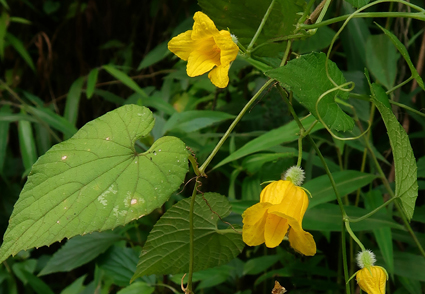Abstract
Thladiantha longipedicellata, a new species of Cucurbitaceae, is described and illustrated from a gorge in southwestern Guangxi, China. It is similar to T. cordifolia and T. grandisepala in its imbricate bracts in the male inflorescence, but it can be chiefly distinguished from both species by having vestigial leaves, longer peduncles and pedicels in the male inflorescence, the shape of male inflorescence, the texture of fruit and female styles split to the base. A character table to distinguish the new species from morphologically similar species as well as color plates for comparison are provided.
References
Bunge, A.A. (1833) Enumeratio Plantarum, quas in China Boreali Collegit. Meìmoires de l’Acadeìmie Impeìriale des Sciences, Saint Petersburg, 147 pp.
Cogniaux, C.A. (1881) Cucurbitacées. Monographiae Phanerogamarum 3: 424.
De Wilde, W.J.J.O. & Duyfjes, B.E.E. (2006) The subtribe Thladianthinae (Cucurbitaceae) in Indochina and Malesia. Blumea 51: 493–518. https://doi.org/10.3767/000651906X622076
IUCN (2022) Guidelines for using the IUCN Red List Categories and Criteria. Version 15.The Standards and Petitions Subcommittee. Available from: https://www.iucnredlist.org/resources/redlistguidelines (accessed 15 February 2022)
IUCN (2012) IUCN Red List Categories and Criteria. Version 3.1. Second edition. The Standards and Petitions Subcommittee. Available from: https://www.iucnredlist.org/resources/categories-and-criteria (accessed 15 February 2022)
Jeffrey, C. (2005) A new system of Cucurbitaceae. Botanicheskii Zhurnal 90: 332–335.
Jeffrey, C. & De Wilde, W.J.J.O. (2006) A review of the subtribe Thladianthinae. Botanicheskii Zhurnal 91: 769.
Jiang, W. & Li, D.Z. (2020) Cucurbitaceae. In: Li, D.Z. (Eds.) The Families and Genera of Chinese Vascular Plants, vol. II. Science Press, Beijing, pp. 1099–1114.
Jiang, W., Li, D.Z. & Wang, H. (2010) Thladiantha tomentosa (Cucurbitaceae) comb. nov. from southwestern China. Nordic Journal of Botany 28 (6): 699–701. https://doi.org/10.1111/j.1756-1051.2010.00758.x
Jussieu, A.L. de (1789) Genera plantarum secundum ordines naturales disposita, juxta methoclum in horto regio parisiensi exaratum. Viduam Herissant and Theophilum Barrois, Paris, 498 pp. https://doi.org/10.5962/bhl.title.7762
Li, J.Q., Wu, Z.Y. & Lu, A.M. (1992) New taxa of the genus Thladiantha (Cucurbitaceae). Acta Botanica Yunnanica 14 (2): 133–134.
Lu, A.M. & Jeffrey, C. (2011) Thladiantha Bunge. In: Wu, Z.-Y. & Raven, P.H. (Eds.) Flora of China. Vol. 19. Science Press, Beijing & Missouri Botanical Garden Press, St. Louis, pp. 21–28.
Lu, A.M. & Zhang, Z.Y. (1981) A revision of genus Thladiantha Bunge (Cucurbitaceae). Bulletin of Botanical Research 1 (1–2): 61–96.
Merrill, E.D. (1940) Records of Indo-Chinese plants, II. Journal of the Arnold Arboretum 21: 386.
Misra, R.C. & Sahoo, H.K. (2014) Thladiantha Bunge (Cucurbitaceae): A new Genus from Odisha and Central India. Vegetos 27 (3): 257. https://doi.org/10.5958/2229-4473.2014.00099.8
POWO (2022) Plants of the World Online. The Royal Botanic Gardens, Kew, Harvard University Herbaria and Libraries & Australian National Botanic Gardens. Available from: https://powo.science.kew.org/ (accessed 18 April 2022)
Schaefer, H. & Renner, S.S. (2011) Phylogenetic relationships in the order Cucurbitales and a new classification of the gourd family (Cucurbitaceae). Taxon 60 (1): 122–138. https://doi.org/10.1002/tax.601011
Yanka, H., Das, A.K. & Das, A.P. (2017) Thladiantha ziroensis Yanka H. & Arup K. Das, sp. nov. (Cucurbitaceae) from Arunachal Pradesh, India. Pleione 11 (2): 485–488. https://doi.org/10.26679/Pleione.11.2.2017.485-488


